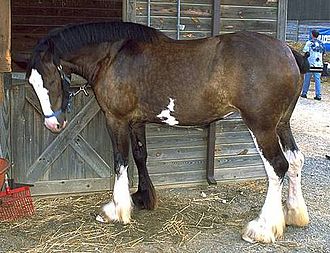AY Honors/Clydesdale
Clydesdale
The Clydesdale is a breed of draft horse derived from the very hard-working farm horses of Clydesdale, Scotland, and named for that region. Thought to be over 300 years old, the breed was extensively used for pulling heavy loads in rural, industrial and urban settings, their common use extending into the 1960s when they were a still a familiar sight pulling the carts of milk and vegetable vendors.
Clydesdales are noted for grace and versatility; they can stand as tall as 18 hands (1.8 meters or 6 feet) in height and up to one ton (2,000 pounds) in weight. A Clydesdale has a large head with somewhat convex profile, small ears, large, dark eyes and a heavy forelock. The neck is short and slightly arched, the chest deep, the shoulders heavy and well-muscled. The back is short, the withers clearly defined, and the rump presents a well-muscled and distinctively rounded silhouette. The legs should be long and strong with characteristically large hoof size, being at least twice the diameter of those of a light riding horse, such as a Thoroughbred.
Clydesdales may be of several possible colors, including various shades of bay (sometimes called brown), roan]], chestnut, and black.
Clydesdales have characteristic long hair, known as feather (not "feathers"), on the lower legs, falling over the hooves. Generally white, the feather can occasionally be black or chestnut, depending on the color of the horse and the presence of markings. Nowadays chiefly for show, this hair was first a result of native stock and breeding with Flemish horses.
Clydesdales have a range of characteristic white markings which are generally present regardless of body color. The most distinctive are four white feet and a blaze, most often a full blaze or large, white "bald face" marking which extends to the lips and chin and may also extend to the eye region.


